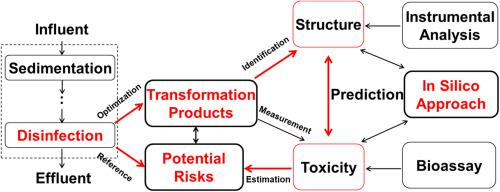Journal of Hazardous Materials ( IF 13.6 ) Pub Date : 2021-02-24 , DOI: 10.1016/j.jhazmat.2021.125495 Miao Chen , Dongbin Wei , Feipeng Wang , Junxia Yin , Min Li , Yuguo Du

|
Levofloxacin (LEV) is a broad-spectrum quinolone antibiotic and widely used for human and veterinary treatment. Overuse of LEV leads to its frequent occurrence in the water environment. In this study, the transformation characteristics of LEV in water during the simulated chlorination disinfection treatment were explored. Fifteen major transformation products (TPs) of LEV were identified, and their plausible formation pathways were proposed. The reaction pathways were strongly dependent on pH condition, and LEV removal was relevant to free available chlorine (FAC) dose. Antibacterial activity of chlorination system was dramatically declined when FAC was more than 3-equivalent (eq) due to the elimination of antibacterial related functional groups. Genotoxicity of chlorination system increased more than 3 times at 0.5-eq of FAC and then decreased with increasing FAC dose, which were in accordance with the relative concentration of toxic TPs estimated by QSAR model. These results implied that the combination of bioassay, QSAR computation and chemical analysis would be an efficient method to screen toxic TPs under chlorination treatment. It is anticipated that the results of this study can provide reference for optimizing operational parameters for water disinfection treatment, and for scientifically evaluating the potential risk of quinolone antibiotics.
中文翻译:

基于生物测定和QSAR的有毒转化产物的筛选及其在左氧氟沙星的氯化处理下的形成
左氧氟沙星(LEV)是一种广谱喹诺酮类抗生素,广泛用于人类和兽医治疗。LEV的过度使用导致其在水环境中频繁发生。本研究探讨了模拟氯化消毒处理过程中LEV在水中的转化特征。确定了LEV的15种主要转化产物(TP),并提出了它们的合理形成途径。反应途径强烈依赖于pH条件,LEV的去除与游离有效氯(FAC)剂量有关。当FAC大于3当量(eq)时,由于消除了与抗菌有关的官能团,氯化系统的抗菌活性急剧下降。氯化系统的遗传毒性在0时增加了3倍以上。FAC的5当量,然后随FAC剂量的增加而降低,这与QSAR模型估计的有毒TP的相对浓度一致。这些结果表明,结合生物测定,QSAR计算和化学分析将是筛选氯化处理中有毒TP的有效方法。可以预期,这项研究的结果可以为优化水消毒处理的操作参数以及科学评估喹诺酮类抗生素的潜在风险提供参考。



























 京公网安备 11010802027423号
京公网安备 11010802027423号